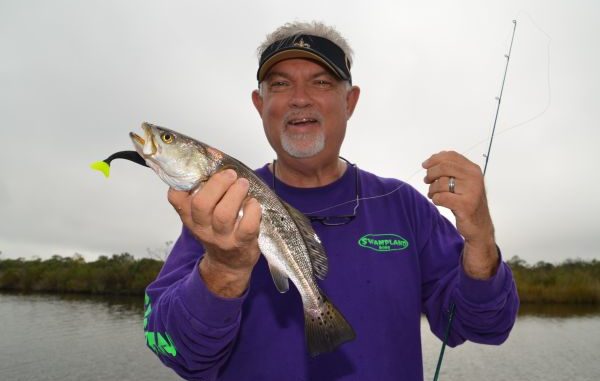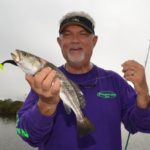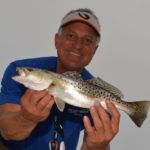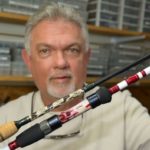
What does every angler need to catch fish? A rod, of course. But choosing the right rod for the job means more than just walking into a tackle store and getting the cheapest offering.
Dawg! What a job!
Here I was in the heart of Terrebonne Parish, field testing handcrafted rods on speckled trout with a “rod master” and a “master of rods.”
I actually get paid to do this.
Lance Dupre, owner of Swampland Tackle (985-852-1703) in Houma, built the rods. The 53-year-old with a ready smile and a devilish goatee has been building rods full time for individuals, corporate customers and guides since 2002.
Even bigger than his rod-building business is his component business, where he sells parts and supplies to other rod builders. He is a distributor for Fuji Products, Batson Enterprises, MHX Rod Blanks and American Tackle Company, and is the exclusive distributor for CastAway Graphite Rods.
Dupre has customers all over the United States, as well as Japan, Spain, Germany, Russia, Argentina and elsewhere.
His Cajun accent gave him away as a native. He grew up in Dulac. His grandfather, Adolph Pellegrin, and his uncles were commercial fishermen, mostly trammel netters and gill netters for redfish. He described his father as a “Houma city slicker.”
Dupre builds everything from ultra-light to offshore trolling rods, but his specialty is speckled trout, redfish and bass rods.
“I really love to build speckled trout rods,” he said.
The “rod-tester-in-chief” on this trip was 55-year-old Tony Fontenot, a Thibodaux native who lives in Schriever. Fontenot spends a lot of time on the water. He owns and hosts Castin’ Cajun Productions, a weekly fishing show televised on Cox Sports Television, as well as other channels.
Warmly friendly, he knows no strangers, but can’t sit still very long. He attributes his frenetic pace to what he puckishly describes as HD/ADD — high definition/attention deficit disorder. Cooking and food (See The Seafood Bible column elsewhere in this edition) are his other passions. He especially loves to eat speckled trout.
And it was a good day for speckled trout.
Although it cleared later, the morning started out both foggy and windy at the same time. Best of all it was cold.
The interior marshes of Terrebonne Parish are famous for speckled trout stacking up in them during the winter. Fishing is good here, even if water temperatures are in the 40s.
Getting most of the press is Lake de Cade, but Fontenot decided to take a stab at working Bayou Sauveur on the opposite side of Bayou du Large from the lake. His plan was to work up and down the bayou, hitting points where bayous, sloughs and canals intersected it.
8:30 in the morning found us launching Fontenot’s bay boat at Jug’s Landing in Theriot. The good thing about fishing in the dead of winter is that early starts aren’t necessary; the warmth that comes from the sun’s rays makes specks more active and typically helps the bite.
Fontenot piloted the boat south down Bayou du Large until the road paralleling it petered out. Then he jumped left under the power lines that continued southward, dashed across shallow-water ponds in broken marsh and into Bayou Sauveur, where he hung a left heading back north.
First stop was a major intersection of the bayou with another one running east-west. Locally called “Four Corners,” it is a well-known winter-time trout producer.
Two boats were already there, and others probed the spot while we fished.
“You ought to see the boats here on a weekend,” Fontenot quipped after he shut the motor down.
He rigged two Dupre-built rods for fishing before he stepped up on the boat’s bow deck. They were simple rigs. One was a soft-plastic paddletail bait on a jighead under a popping cork. The other was a soft-plastic paddletail on a jighead fished tight-lined — without a cork.
“You try both techniques and go with the one that works,” he explained.
This day, tight-lining was the ticket. The pair picked up several specks at the first stop. They soon fell into a fishing rhythm. When the fish quit giving, Fontenot would get antsy and move the boat up the bayou to the next point or corner. Sometimes he ran short distances up the intersecting bayous to fish points.
Almost every spot yielded a few specks. Typical of cold-weather fishing, no place produced a feeding frenzy, but trout seemed to be everywhere. They gave up in equal numbers to the pair, in spite of dramatically different fishing styles.
Fontenot whipped the water into foam, casting in every direction as far as he could reach. Dupre, on the other hand, fished leisurely, retrieving his lure or a hooked fish slowly; he was so laid back it was hard to believe that he was once a competitive bass fisherman.
As he slowly reeled in one particularly nice speck, seeming to enjoy the fight, the fish got off the hook right at the boat.
“Man, you got to keep him coming!” Fontenot said, as if alarmed. “When you got the momentum, you got to swing him into the boat.”
He said this while demonstrating the required action.
Dupre’s disarming response was made with a broad grin.
“I guess I missed a fish sandwich, huh?”
He was obviously referring to the bass po-boys that Fontenot supplied to us for breakfast that morning.
Fontenot could only respond with a hearty laugh and a head shake.
As he caught trout after trout, he complimented Dupre on the rod he is using.
“Man, I like this rod. It’s not too stiff and it’s not too limber,” Fontenot said.
Obviously pleased, Dupre explained why.
“It’s built with the best and lightest blanks and the lightest components,” he said. “The two-piece reel seat helps, too. It eliminates weight.
“The less weight a rod has, the more sensitive it is.”
The ice box in the bow of the boat began to fill up with specks. None were over a pound and a half, but none were shy of the 12-inch minimum-size mark, either.
In spite of all his bites coming by tight-lining, Fontenot picked up his cork-rigged rod.
Dupre’s voice flowed a little plaintively from the back of the boat.
“I wish that you wouldn’t have put a cork on that rod,” he said.
Fontenot’s head snapped up.
“Say what?” he asked.
“It’s too sensitive,” Dupre replied. “It’s a waste! I build other rods specifically for cork fishing.”
“OK,” Fontenot drawled out, as if wanting to hear more, as he inserted the rod back into its holder.
Dupre obliged.
“I build three kinds of rods: jig rods, topwater rods and cork rods. Jig rods have fast to extra-fast action, with a light and sensitive tip. They are around 7 feet long and have either a one or two-piece reel seat.
“Topwater rods are 6 feet, 6 inches long to 6 feet, 10 inches long. They have fast to extra-fast action and a sensitive tip. The shorter rod means that it is easier to make accurate casts. The handle is shorter, so it doesn’t jab you in the gut all the time. Two or 3 inches shorter in the handle makes a big difference.
“My cork rods are 7 feet long with a moderate to fast tip on a medium rod. It will bend more and is more forgiving to fight a fish with. A cork on a line adds a lot of extra weight.”
A glance at Fontenot on the bow revealed that, for the first time in the morning, he wasn’t frenetically casting, but rather raptly listening.
Encouraged, Dupre went on.
“A lot of people misunderstand the terms ‘action’ and ‘power,’” he said. “‘Power’ reflects the stiffness of a rod — how much pressure it takes to bend the rod. Ratings are ultra-light, light, medium light, medium, medium heavy, heavy, extra heavy and extra extra heavy.”
The way Dupre explained it, power is the same thing anglers sometimes refer to as “backbone” in a rod. Power is closely tied to the line strength for which a rod is rated. A heavy-power rod can snap light lines, and a light rod can be snapped by heavy lines. The power rating of a rod is usually written on the rod itself.
Ideal for speckled trout fishing are light and medium-light power rods, Dupre said.
He went on.
“‘Action,’ what some people confuse with power, refers to how much of a rod flexes,” Dupre said. “Action is rated using speed terms. In an extra-fast rod, only the upper 20 percent bends. For fast action it is 30 percent; medium-fast, 35 percent; moderate-fast, 40 percent; moderate, 50 percent; and with slow-action the rod flexes progressively from tip to butt.
“The best trout rods are fast to moderate fast.”
Fontenot was still standing in the bow, standing stock still and listening to the lesson.
“Man, I’m learning a lot!” he said more to himself than anyone else.
Meanwhile, Dupre landed and boxed another fish. He had been steadily fishing while he lectured, and was pulling ahead of Fontenot in the body count.
Fontenot went to work. After unceremoniously wrestling in a couple more fish, he croaked to Dupre again, “I like this rod.”
“Good,” Dupre mugged. “I’ll sell you four more — but you know if you break it, you know there’s no warranty.
Both men were having fun.





